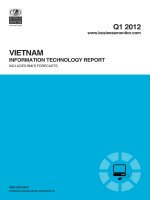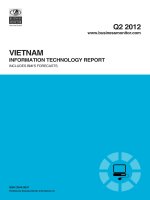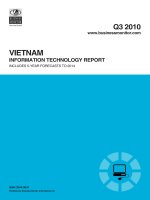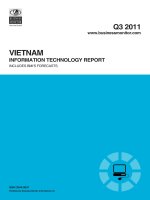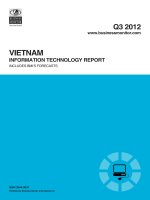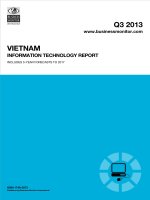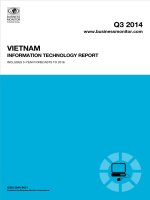Israel information technology report q3 2012
Bạn đang xem bản rút gọn của tài liệu. Xem và tải ngay bản đầy đủ của tài liệu tại đây (521.34 KB, 74 trang )
Q3 2012
www.businessmonitor.com
ISraeL
information technology Report
INCLUDES BMI'S FORECASTS
ISSN 1752-4245
Published by Business Monitor International Ltd.
ISRAEL INFORMATION
TECHNOLOGY REPORT
Q3 2012
INCLUDES 5-YEAR FORECASTS TO 2016
Part of BMI’s Industry Report & Forecasts Series
Published by: Business Monitor International
Copy deadline: July 2012
Business Monitor International
85 Queen Victoria Street
London
EC4V 4AB
UK
Tel: +44 (0) 20 7248 0468
Fax: +44 (0) 20 7248 0467
Email:
Web:
© 2012 Business Monitor International.
All rights reserved.
All information contained in this publication is
copyrighted in the name of Business Monitor
International, and as such no part of this publication
may be reproduced, repackaged, redistributed, resold in
whole or in any part, or used in any form or by any
means graphic, electronic or mechanical, including
photocopying, recording, taping, or by information
storage or retrieval, or by any other means, without the
express written consent of the publisher.
DISCLAIMER
All information contained in this publication has been researched and compiled from sources believed to be accurate and reliable at the time of
publishing. However, in view of the natural scope for human and/or mechanical error, either at source or during production, Business Monitor
International accepts no liability whatsoever for any loss or damage resulting from errors, inaccuracies or omissions affecting any part of the
publication. All information is provided without warranty, and Business Monitor International makes no representation of warranty of any kind as
to the accuracy or completeness of any information hereto contained.
Israel Information Technology Report Q3 2012
© Business Monitor International Ltd
Page 2
Israel Information Technology Report Q3 2012
CONTENTS
Executive Summary ......................................................................................................................................... 5
SWOT Analysis ................................................................................................................................................. 7
Israel IT Sector SWOT ........................................................................................................................................................................................... 7
Israel Telecoms Industry SWOT............................................................................................................................................................................. 8
Israel Political SWOT ............................................................................................................................................................................................ 9
Israel Economic SWOT ........................................................................................................................................................................................ 10
Israel Business Environment SWOT .................................................................................................................................................................... 11
MEA IT Risk/Reward Ratings ........................................................................................................................ 12
Table: MEA Q312 IT Risk/Reward Ratings ......................................................................................................................................................... 14
IT Markets Overview....................................................................................................................................... 15
IT Penetration ...................................................................................................................................................................................................... 15
Sectors And Verticals ........................................................................................................................................................................................... 18
Market Overview ............................................................................................................................................. 22
Government Authority.......................................................................................................................................................................................... 22
Background.......................................................................................................................................................................................................... 22
Government Initiatives......................................................................................................................................................................................... 23
Hardware............................................................................................................................................................................................................. 24
Software ............................................................................................................................................................................................................... 25
Services................................................................................................................................................................................................................ 27
Outsourcing ......................................................................................................................................................................................................... 28
Industry Developments ........................................................................................................................................................................................ 29
Offshoring ............................................................................................................................................................................................................ 29
E-Services ............................................................................................................................................................................................................ 30
Israel's Digital Divide .......................................................................................................................................................................................... 30
Industry Forecast ........................................................................................................................................... 32
2012 Outlook ....................................................................................................................................................................................................... 32
Market Drivers .................................................................................................................................................................................................... 33
Opportunities ....................................................................................................................................................................................................... 33
Table: Israel IT Industry – Historical Data And Forecasts (US$mn unless otherwise stated) ............................................................................. 34
Industry Forecast Internet ............................................................................................................................. 35
Table: Internet Data And Forecasts, 2009-2016.................................................................................................................................................. 35
Competitive Landscape ................................................................................................................................. 37
Macroeconomic Forecast .............................................................................................................................. 42
Table: Israel – Economic Activity, 2011-2016 ..................................................................................................................................................... 44
Company Profiles ........................................................................................................................................... 45
Ness ..................................................................................................................................................................................................................... 45
Hewlett-Packard .................................................................................................................................................................................................. 48
Matrix .................................................................................................................................................................................................................. 54
IBM ...................................................................................................................................................................................................................... 57
Microsoft Corporation ......................................................................................................................................................................................... 62
© Business Monitor International Ltd
Page 3
Israel Information Technology Report Q3 2012
Country Snapshot: Israel Demographic Data.............................................................................................. 67
Table: Israel's Population By Age Group, 1990-2020 ('000) ............................................................................................................................... 68
Table: Israel's Population By Age Group, 1990-2020 (% of total) ...................................................................................................................... 69
Table: Israel's Key Population Ratios, 1990-2020............................................................................................................................................... 70
Table: Israel's Rural And Urban Population, 1990-2020 .................................................................................................................................... 70
BMI Methodology ........................................................................................................................................... 71
How We Generate Our Industry Forecasts .......................................................................................................................................................... 71
Transport Industry ............................................................................................................................................................................................... 71
Sources ................................................................................................................................................................................................................ 72
© Business Monitor International Ltd
Page 4
Israel Information Technology Report Q3 2012
Executive Summary
BMI View: Israeli IT spending is expected to reach US$5.8bn in 2012, up 2%, lower than previously
forecast, due to the global economic headwinds. In Q112, several indicators suggested moderating
consumer demand, but vendors still reported a solid trading environment for IT services across
industrial, government, defence and financial services segments. The Israeli IT market should gain
enough momentum from key sectors to expand at a CAGR of 8% over BMI's 2012-2016 forecast period,
due to momentum from key segments.
Headline Expenditure Projections
Computer hardware sales: US$2.5bn in 2011 to US$2.5bn in 2012, +1% in US dollar terms. Forecast in
US dollar terms downwardly revised due to macroeconomic factors, but Israeli businesses are investing
more to facilitate expansion and development.
Software sales: US$1.3bn in 2011 to US$1.3bn in 2012, +3% in US dollar terms. Forecast in US dollar
terms downwardly revised due to analyst modification, but device and data proliferation will drive
spending on customer relationship management (CRM), databases and business intelligence.
IT services sales: US$2.0bn in 2011 to US$2.0bn in 2012, +3% in US dollar terms. Forecast in US dollar
terms downwardly revised due to analyst modification but key segments such as government and defence
will be a continued source of opportunities.
Risk/Reward Ratings: Israel's score was 66.5 out of 100.0. Israel ranks first in our latest RRR table,
ahead of Qatar and the UAE.
Key Trends & Developments.
BMI forecasts overall solid growth for the Israeli IT market for 2012, despite a deteriorating
external economic environment. Businesses will maintain a cautious attitude to IT investments
due to uncertainty about a sustainable global economic recovery in key export markets. There
should, however, be growth in areas such as business intelligence, server virtualisation, mobile
devices and cloud computing.
New cloud computing offerings and increased competition in this segment should fuel further
demand from users. Particular areas of opportunity for cloud computing include banking and
retailing as organisations in those fields look to save money on hardware investments.
Businesses will, not only seek to make cost savings, but will look to boost efficiency and
increase flexibility of response to customer needs.
© Business Monitor International Ltd
Page 5
Israel Information Technology Report Q3 2012
The Israeli government has launched various initiatives to increase computer and internet
penetration. The current rate of PC penetration, while high for the region, represents potential for
organic growth. Household penetration is estimated at around 75%. Due to digital divide issues,
Israel has around 600,000 children living below the poverty line and only 3% have internet or
home PC access, compared with 90% in the top income group.
© Business Monitor International Ltd
Page 6
Israel Information Technology Report Q3 2012
SWOT Analysis
Israel IT Sector SWOT
Strengths
Weaknesses
Opportunities
Threats
One of the most modern economies in the region, with a highly educated,
linguistically skilled workforce, and relatively low labour costs compared with
most developed countries.
Strong defence and government spending provides base for IT demand.
Relatively mature IT market, with services accounting for an estimated 33% of
spending in 2009. Despite this, the market for basic IT hardware and software is
far from saturated.
Strong political support, with the government having implemented many policies
to aid in the development, success and expansion of the IT sector.
The recession at the beginning of the 2000s created a client mentality of
focusing on the bottom line, with enhanced services and customer market
power adding to pressure on pricing and margins.
Digital divide, with 3% of bottom-income group having home internet access.
Despite the financial crisis, the financial services sector, which accounts for
around 15% of spending, will have to spend on compliance with Basel II and
other international standards, driving growth.
Defence and government projects should be less sensitive to the economic
downturn.
Outsourcing, Software-as-a-Service (SaaS) and applications management likely
to grow fastest out of IT services, with particular opportunities in financial sector.
Opportunities for partnership/investment in Israel's lively local IT company
sector.
Healthcare IT will be a growing source of opportunity.
Economic downturn and unemployment will lead to weaker consumer and
business sentiment.
Other factors may affect business confidence, notably the security situation.
The weaker local currency, and aggressive pricing, may continue to constrain
growth and put pressure on margins.
© Business Monitor International Ltd
Page 7
Israel Information Technology Report Q3 2012
Israel Telecoms Industry SWOT
Strengths
Weaknesses
Opportunities
Threats
Well-developed internet/broadband sector compared with regional peers.
Liberal mobile market consisting of four operators.
Mature market with strong take-up of value-added and 3G services.
Mobile penetration rate of over 120% means growth in the mobile market has
slowed considerably and operators must look for alternative revenue sources.
Lack of competition in all telecoms sectors.
Regulator has been slow to license new services, such as WiMAX wireless
broadband.
Voice over Internet Protocol (VoIP) licensing and triple-play for Bezeq placed on
hold, which could hinder prospects.
Emergence of rival operator HOT Telecom, made up of the main three cable
operators (Golden Channels, Matav and Tevel) to compete against Bezeq,
could provide cheaper services.
Introduction of number portability and the entry of mobile virtual network
operators (MVNOs) to the mobile sector could shake up competition and drive
down retail prices for consumers.
Continued interconnection tariff reduction could have a devastating effect on
operators' revenue.
Operators, Bezeq in particular, have resisted the introduction of number
portability, which could lead to a price war and drive down mobile revenue.
Operators are also hostile to the introduction of MVNOs.
© Business Monitor International Ltd
Page 8
Israel Information Technology Report Q3 2012
Israel Political SWOT
Despite corruption allegations against some officials and members of
parliament, government members are still some of the most accountable in the
region.
Elections are for the most part free and transparent, ensuring that a broad
spectrum of political views are represented within government.
The protracted conflict with the Palestinians means there are persistent security
risks, although violence in the West Bank has been reduced significantly.
Strategies to minimise or end the conflict are domestically divisive.
Frequent change to the composition of the coalition government often leads to
policies becoming fragmented or significantly diluted.
The fallout between Turkey and Israel, caused by the Gaza flotilla incident of
May 2010, has meant that Israel has lost a key Middle East ally.
Opportunities
A warming of relations with Greece has given Israel the ability to engage in
military exercises over a larger geographic area.
Threats
The victory of Hamas in the 2006 Palestinian elections, its subsequent takeover
of the Gaza Strip, and Israel's military incursion into the territory in December
2008/January 2009 has added to uncertainty. Finding a lasting solution poses a
dilemma for Israel, which has previously said it will not talk to the militant
organisation.
The construction of the West Bank barrier and the continued home-building in
some West Bank settlements antagonises the Palestinians and stands in the
way of the peace process.
Iranian President Mahmoud Ahmadinejad's refusal to give up his country's
nuclear programme raises concerns that nuclear weapons could be used
against Israel in the future.
Strengths
Weaknesses
© Business Monitor International Ltd
Page 9
Israel Information Technology Report Q3 2012
Israel Economic SWOT
Strengths
Weaknesses
Opportunities
Threats
The policy framework has stabilised in recent years with fiscal deficits brought
well under control.
The workforce is highly educated and skilled.
The country's close ties with the US provide it with substantial financial
assistance for economic and military ends.
The main downside risk to the economy is the security situation. A sharp
deterioration can have an immediate impact on domestic confidence, tourism
receipts, the exchange rate and foreign investment.
The economy is highly exposed to that of the US, in terms of exports,
investment and remittances.
In the long term, rising levels of employment will underpin private consumption
growth.
Israel produces more technology start-up companies than any other country in
the world except the US.
The discovery of large offshore gas deposit will bring foreign investment and is
expected to serve the country's energy needs for decades.
Israel's energy supplies are not stable at the moment – the Egypt-Israel gas
pipeline has been targeted frequently in 2011, forcing the country to buy more
expensive fuels from alternative sources.
Competition from emerging Chinese and Indian producers of high-tech goods
and polished diamonds, as well as sluggish growth in the eurozone, could
undermine demand for Israeli exports.
© Business Monitor International Ltd
Page 10
Israel Information Technology Report Q3 2012
Israel Business Environment SWOT
Strengths
Weaknesses
Opportunities
Threats
The business environment is supported by sound infrastructure and
communication networks, as well as transparent legislation.
The banking system is one of the most sophisticated in the region, and offers a
wide range of both consumer and commercial credit products.
Historic political instability increases the risk premium of investment in Israel.
Some limits on repatriation of capital exist and there are constraints on foreign
investment in the high-tech sector.
Corporate tax rates, at 25%, have not increased markedly as a result of social
protests in 2011.
The Qualified Industrial Zone agreements with Jordan and Egypt boost the
potential for trade.
Strike action has proved extremely disruptive to the business environment over
the past two years.
The parliament approved a plan to increase the country's oil and gas royalties,
which could reduce energy profits in the future.
© Business Monitor International Ltd
Page 11
Israel Information Technology Report Q3 2012
MEA IT Risk/Reward Ratings
BMI's Q312 update to the Middle East and Africa IT Markets Risk/Reward Ratings contains changes
from our previous update, driven mainly by IT Market and Country Risk factors. The ratings reflect our
assessment of key growth drivers and risks to outlook in the IT markets of the 11 countries in our regional
coverage.
The information and communications technology (ICT) sector is a key focus of most countries in the
region, firstly as a key part of their diversification strategy away from hydrocarbons, and secondly
because of the growth of ICT services globally and the increasing integration of IT services with other
industry verticals. In addition to governments' strategic view of the ICT sector, we expect increases in
disposable incomes in the region, following public sector wage rises to drive growth in the consumer
segment of IT markets across the region.
Israel retains top spot on our RRR table this quarter following a slight increase to its aggregate score from
66 to 66.5. The country has one of the most developed IT markets in the region, reflected by household
computer penetration of more than 75% and significant government and military expenditure on IT
projects. Israel's well educated population, strong policies for IP protection, stable political environment
and developed telecoms infrastructure also make it an attractive location for global IT players to site key
R&D and production facilities.
Qatar moves into second position this quarter, displacing the UAE which drops to third place, following
changes to its Country Risk rating and an upgrade to Qatar's IT Market rating. We downgraded Qatar and
the UAE's Country Risk scores this quarter from 76 and 72.7 to 69.7 and 67 respectively, to account for
the likely slowdown in economic growth because of the downward pressure on crude oil prices driven by
economic crisis in Europe and a possible slowdown in China. However, an upgrade to Qatar's IT Market
score, as a result of strong demand for IT products and services in that country, led to a marginal net gain
its aggregate score this quarter.
Kuwait retains fourth place despite a slight decrease to its overall score this quarter. The sharp increase in
government expenditure in 2011, which BMI expects to continue into 2012, provides a favourable
platform for strong demand for consumer and corporate IT products and services. However, the country
continues to be held back by a relatively small population and, consequently, a small-sized consumer
market. Bahrain, which drops to seventh from fifth in this quarter's update, also faces similar limitations
to its IT market potentials. Bahrain's IT Market score of 26.3 is considerably lower than the regional score
of 30.7. The heightened risk in Bahrain's political environment, with the likelihood of continued antigovernment protests in the short term, also led to a downgrade of Bahrain's Country Risk score this
quarter.
© Business Monitor International Ltd
Page 12
Israel Information Technology Report Q3 2012
Saudi Arabia and Turkey moved up one place each into fifth and sixth positions, following Bahrain's slip.
Both countries boast large populations, strong demographics and better performing economic growth
compared to many of their neighbours. There have also been significant investments into the telecoms
sector in both countries, a development we expect to sustain demand for IT services.
Oman moves up one place into eighth position on our table this quarter to displace South Africa which
drops one place into ninth. There is no change to Oman's aggregate score from last quarter, but South
Africa's IT Market score is downgraded from 47.3 to 44.9 to reflect the effect of slower economic growth
on demand for high-value IT services, especially in the consumer segment. That said, we note that South
Africa's large population and developed industry verticals such as financial services and retail make it an
attractive market for IT services.
Egypt drops into last position this quarter, although there is no change to its aggregate score. The country
was leapfrogged by Lebanon whose aggregate score was boosted by an upgrade to its Country Risk score.
Lebanon has some advantages in the form of its geographical location and youthful population. However,
we retain our view that sustainable growth in the ICT sector depends on political stability and the
implementation of necessary reforms such as liberalisation of the telecoms market to drive growth. Egypt
also has the potential to be a regional IT hub considering its large population size, young and educated
population, an expanding middle class and geographical location. However, the ongoing political crisis in
the country is undermining its potential. Perhaps a successful transition to democracy after presidential
elections in May/June 2012 will provide the much needed stability to drive growth and investments.
© Business Monitor International Ltd
Page 13
Israel Information Technology Report Q3 2012
Table: MEA Q312 IT Risk/Reward Ratings
Limits Of Potential Return
Country
IT Market Structure
Risks To Realisation Of
Returns
Limits
Market
Risks
Country
Risks
Risks
IT Risk/
Reward Regional Previous
Rating Ranking Ranking
Israel
51.00
100.00
68.15
55.00
67.69
62.61
66.49
1
1
Qatar
38.13
100.00
59.78
50.00
69.66
61.80
60.39
2
3
UAE
40.67
90.00
57.93
60.00
66.98
64.19
59.81
3
2
Kuwait
34.38
100.00
57.34
40.00
66.68
56.01
56.94
4
4
Saudi Arabia
36.88
70.00
48.47
45.00
67.68
58.61
51.51
5
6
Turkey
49.50
55.00
51.43
45.00
45.11
45.06
49.52
6
7
Bahrain
26.25
75.00
43.31
57.50
61.83
60.10
48.35
7
5
Oman
27.50
70.00
42.38
50.00
60.52
56.31
46.56
8
9
South Africa
44.92
45.00
44.95
35.00
58.72
49.23
46.23
9
8
Lebanon
30.67
65.00
42.68
20.00
41.53
32.92
39.75
10
11
Egypt
40.00
25.00
34.75
40.00
50.59
46.35
38.23
11
10
38.2
72.3
50.1
45.2
59.7
53.9
51.3
Average
Scores are weighted as follows: 'Rewards': 70%, of which Industry Rewards 65% and Country Rewards 35%; 'Risks':
30%, of which Industry Risks 40% and Country Risks 60%. The 'Rewards' rating evaluates the size and growth potential
of a telecoms market in any given state, and country's broader economic/socio-demographic characteristics that impact
the industry's development; the 'Risks' rating evaluates industry specific dangers and those emanating from the state's
political/economic profile, based on BMI's proprietary Country Risk Ratings that could affect the realisation of
anticipated returns. Source: BMI
© Business Monitor International Ltd
Page 14
Israel Information Technology Report Q3 2012
IT Markets Overview
IT Penetration
The Middle East region divides into two
groups in terms of information society
development. In the first group are richer
Internet Penetration
Per 100 Population
and more technologically advanced
countries, such as Israel and the UAE,
where internet penetration is relatively
high and many households have access to
broadband services. In more emerging
markets such as Egypt, on the other hand,
computers remain a luxury for many.
Across the MEA region, the number of
internet users is expected to grow
significantly. South Africa is projected to
f = BMI forecast. Source: BMI
advance the most in percentage terms,
with penetration rising from about 16.3% in 2012 to 24.1% by 2016 (note: figures may vary elsewhere in
report due to updated forecasts after time of writing). Egypt, where the second biggest increase is
forecast, will have 55.4% penetration by 2016, up from 40.1% in 2012. The UAE is one of the most eready states in the region, with internet penetration seen as reaching 78.1% within the forecast period.
Growth in the number of internet subscribers is also forecast to pick up in Saudi Arabia, with a 21%
increase between 2012 and 2016.
Similar contrasts are apparent in relation to broadband penetration, where mobile broadband is now a
major driver of overall penetration, due to 3G mobile service roll-outs across the region, and a
proliferation of mobile connectivity devices such as smartphones and tablets. Broadband penetration,
which currently ranges from 5.8% in Kuwait to 41.4% in Saudi Arabia.
Government initiatives are afoot in most places, ranging from wireless broadband in Dubai to plans to
deploy optical fibre extensively in countries such as Kuwait. BMI's broadband penetration forecasts have
been downgraded in many markets as a result of the economic downturn, with Saudi Arabia's 55.5%
penetration see as the highest in 2016. Israel is projected to reach 28%, ahead of Qatar with 26.6%, the
second and third highest respectively among the countries covered by BMI.
© Business Monitor International Ltd
Page 15
Israel Information Technology Report Q3 2012
Internet and broadband penetration growth will receive boosts from continued efforts to liberalise
regional telecoms markets. Moves towards telecoms market liberalisation have continued in Qatar, Egypt,
Saudi Arabia and other countries. Broadband penetration has become a driver of PC ownership in some
segments, due to the growing variety of multimedia and communication services available.
There is also considerable PC market
growth potential as the current level of
computerisation is estimated at less than
Broadband Penetration
Per 100 Population
50% in every country in the region. PC
penetration in Egypt is estimated at
around 10% and is forecast to rise to
above 20% by 2016. In Saudi Arabia, PC
penetration is currently above 25% and
should increase to around one-third by
2016. Even in Israel, where household
penetration is estimated at above 75%,
there is potential for further growth.
Government initiatives will drive more
f = BMI Forecast. Source: BMI
use of computers in education. In 2011,
the Egyptian government announced a EGP150bn new school building programme, which should provide
opportunities for IT suppliers. Around 25% of Egypt's schools are not equipped with computers. In the
UAE, the Ministry of Education is leading an initiative to supply computers to state schools. Meanwhile,
the South African Department of Education has announced a target of rolling out laptops to all school
children in the country by 2014.
Governments in the region have also allocated significant budgets for e-government development. The
Qatari government has outlined plans to invest QAR6bn (US$1.6bn) in information technology and IT
services as part of its ICT-2015 strategy. The Kuwaiti government plans to spend US$104.3bn over the
next four years, in an attempt to diversify the economy away from oil and boost the private sector. Egypt
aims to make 200 government services available soon online through a new e-government portal.
Meanwhile, Qatar's e-government programme and Hukoomi e-services portal will continue to drive
investment in computer hardware across government agencies and client organisations. South Africa's
IFMS (Integrated Financial Management Systems) project manages the evolution of government IT
systems to support interoperability and e-government service development.
Another key policy priority throughout the region is to increase utilisation of IT by businesses and in
particular small and medium-sized enterprises (SMEs). One of the Saudi government policies that
© Business Monitor International Ltd
Page 16
Israel Information Technology Report Q3 2012
vendors are capitalising on is the United Instalment Scheme (USI) finance option, which makes highquality notebooks available to SMEs. Qatar's ICT governing body, ictQatar, has made increasing SME
utilisation of IT a key policy objective. However, access to credit remains a barrier for smaller companies
in Egypt and elsewhere.
Drivers are increasing economic
diversification and strong spending from
non-oil sectors such as government,
Market Size
As % Of National GDP
finance and enterprise. By 2016, this
should be more evident, with IT's share
of GDP rising in many countries. In
Saudi Arabia, for example, governmentdriven investments in transportation,
property constructions and water and
power plants will drive opportunities for
IT vendors.
An expected recovery in population
growth underpins our IT market growth
f = BMI forecast. Source: BMI
projections for markets such as the UAE
and Kuwait, which saw an exodus of expat workers in 2009. In particular, strong positive population
growth gives Saudi Arabia an advantage, with growth expected to reach 10% by the end of our five-year
forecast period.
Across much of the MEA region, youthful population demographics and rising PC penetration will drive
growth. An evolving retail landscape will also help to stimulate sales, with the traditional domination of
smaller stores having been diluted by the appearance of multi-brand electronics sections in hypermarkets
and mono-brand stores in malls.
In many Middle Eastern states, the hydrocarbon sector remains a key one for IT spending. Expected
increases in both oil output and prices should provide support for higher IT budgets in this vertical.
Regional sector giants such as Saudi Aramco and Kuwaiti leader KNPC are investing in IT to enhance
operational efficiency, optimise cost structures and boost overall business agility.
The banking sector will also remain a major user of technology as banks and other financial services
organisations look to become more efficient and launch new services. Telecoms is another growth area
for technology spending, as service providers look to exploit the potential for increased revenue
generation from new services by implementing tools that facilitate more personalised offers to customers.
© Business Monitor International Ltd
Page 17
Israel Information Technology Report Q3 2012
In the wake of the political unrest that
swept the Arab world in the first half of
IT Market Compound Growth
2011, government spending is expected
2012-2016 (%)
to help address economic concerns that
may have underpinned dissatisfaction in
some cases. To help maintain social
stability, the Saudi government has
announced US$93bn in handouts,
including wage increases, which should
boost consumer spending on electronic
items such as PCs. However, a further
deterioration of political stability in
countries such as Egypt could potentially
cause disruptions to distribution networks
Source: BMI
and have an impact on outsourcing
operations.
The highest growing IT market in the MEA IT market over the forecast period is expected to be Egypt,
with compound growth of 89% for 2012-2016. There is room for considerable growth in the country in
the next few years, given the current low level of computerisation, which is much higher in the business
sector than in the population at large. BMI highlights strong growth for GCC countries, including Qatar
(47%), where the decision to award Qatar the 2022 FIFA World Cup is expected to fuel a wave of
investment in IT products and services. Government spending, investment and private consumption
growth are all expected to trend upwards in 2012, as Qatari real GDP growth reaches a projected 28.6%
in US dollar terms. Other high-growth opportunities are forecast to include the UAE (72%) and South
Africa (66%).
Sectors And Verticals
Hardware will continue to dominate MEA IT spending as the number of personal computer users rises
steadily over the forecast period. This will be driven by growing affordability, government initiatives and
the popularity of notebooks. There could be a boost from computer hardware tenders delayed as a result
of the economic situation.
Sales of notebooks are growing roughly twice as fast as desktops in many markets. In 2011, Saudi
retailers reported a surge in demand mobile PCs, in many cases fuelled by price cuts. PC sales were
stronger than previously expected, although this growth was driven in part by promotional price cutting.
© Business Monitor International Ltd
Page 18
Israel Information Technology Report Q3 2012
The notebook sector was the main factor driving retail segment growth across the region in 2011 as
consumer sales felt the benefits of aggressive channel promotions. Notebooks are expected to account for
more than 60% of total sales over the forecast period. However, in a few markets such as Egypt, desktops
still account for around half of the total PC market in volume terms.
Much of the growth of notebooks has been driven by price cuts. In 2011, average notebook costs dropped
by up to 25% for some models. Many notebooks now retail in the price range US$544 to US$680, down
from an average price of around US$800 before the financial crisis. The launch of notebooks based on the
Android operating system has supported this trend, as Android netbooks are often cheaper than Windows
7 ones.
However, the growing popularity of tablets is expected to provide a growth area in 2012, after the product
category enjoyed a surge of popularity in 2011, fuelled by Apple's iPad. Tablets will be a growth area
across the region in 2012, and the devices, originally seen as primarily for consumers, are forecast to
experience increasing take-up in the business segment. However, the popularity of alternative
connectivity devices such as tablets and smartphones has undercut replacement sales of notebooks.
Market Structure
% Of Total IT Market
f = BMI forecast. Source: BMI
Government programmes in Egypt and Saudi Arabia have made low-price computers available in easy
instalment payment schemes. Government investment in education and e-services will mean desktop
purchases for schools, colleges and government offices.
Spending on software as a share of total IT spending is as low as 14% in Egypt and below 20% in a
majority of MEA markets. As the regional economy improves, more investment is likely to be driven by
© Business Monitor International Ltd
Page 19
Israel Information Technology Report Q3 2012
plans for expansion, rather than merely to realise cost efficiencies. Similarly the growing regional
ambitions of South African companies will be a factor driving corporate spending on software in that
market,
Across the region however, many businesses remain focused on costs, and software vendors will pitch
efficiency gains from virtualisation and cloud computing, as companies focus on return on investment.
2012 should, however, see a boost from systems upgrades deferred from 2009. Migrations to the
Windows 7 operating system and new Intel core technology could trigger a new cycle of hardware
upgrades, although much will depend on business and consumer confidence. Around half of Saudi
businesses still use computers based on the Windows XP operating system. Meanwhile, about one-third
of computers in the UAE are still based on the Windows XP operating system.
BMI predicts plenty of room for software market growth over the forecast period as numerous untapped
sectors still exist. Key verticals will include telecoms, finance, retail, healthcare and the public sector.
There has been growing demand in the market for applications tailored towards particular verticals. SMEs
are likely to lead spending growth, with manufacturing and trading firms seeking efficiencies by making
the transition from manual environments to full automation of back-office systems. Customer relationship
management (CRM) will be a growth area, and other high-growth categories are set to include business
intelligence, storage and security products. The security software market is very important throughout the
region as increased investments in IT hardware over recent years are now driving spending on secure
content management technologies.
There are some challenges for the regional software market. One key issue is that of illegal software:
across the region, up to 80% of software is counterfeit. Another important factor is low income, including
the high costs of operating systems such as Windows, which has led to activity to promote open source in
countries such as Egypt, championed by IBM and other vendors.
Over BMI's five-year forecast period, software-as-a-service (SaaS) business models are expected to
provide a growing opportunity for vendors, with increasing demand for industry-specific applications.
Government adoption will also be a key driver in many countries, such as the UAE where cloud services
are central to the emirates government's e-government strategy for the next three years.
BMI predicts that demand for IT services will grow strongly during the 2012-2016 period. The regional
IT services market is dominated by demand from oil and gas, government, finance and telecoms sectors,
which many markets account for more than half of total spending. In markets such as Saudi Arabia, most
enterprise application spending still comes from segments such as oil and gas and banks. However, more
projects are expected in segments such as education and health.
© Business Monitor International Ltd
Page 20
Israel Information Technology Report Q3 2012
Currently, IT services' share of IT spending ranges from around 25% to 37% in the MEA countries
covered by BMI. Support and maintenance account for around one-third of spending on IT services, but
demand for more complex services has increased, with large outsourcing deals in the UAE, Israel and
elsewhere. There is also demand for services such as hosting, facilities management and disaster
recovery.
Vendors have reported an evolution in demand for services, with a shift away from the dominance of
product implementation and installation to greater interest in managed services, value-added services,
facilities management, hosting and business continuity and disaster recovery. Even in less mature markets
such as Egypt, larger customers are becoming more demanding in terms of their IT expectations.
In both the private and public sectors, MEA organisations are looking for help to utilise efficiencies from
cloud computing services such as SaaS and infrastucture-as-a-service (IaaS). Surveys suggest that cloud
spending was an IT investment priority for around one-quarter of MEA businesses in 2011. Cloud
services are central to the UAE's e-government strategy for the next three years. In 2011, Kuwaiti data
communications services providers such as Zajil signed agreements with partners to expand their cloudbased product offerings. Particular areas of opportunity for cloud computing include government, banking
and retailing as organisations in those fields look to save money on hardware investments.
Cloud computing is also becoming viable in markets such as South Africa due to improved and lowercost bandwidth availability.
© Business Monitor International Ltd
Page 21
Israel Information Technology Report Q3 2012
Market Overview
Government Authority
Government Authority
Ministry of Science and Technology
Minister
Daniel Hershkowitz
The Ministry of Science and Technology has undergone numerous name changes and received its current
name following the election of Binyamin Netanyahu's government in March 2009.
The ministry's responsibilities include forming a national science and technology policy, coordinating
research areas and technological analysis and organisation.
The main priorities for the ministry are as follows:
Establishing a national policy and priorities for R&D;
Developing scientific and technological infrastructure;
Establishing and strengthening foreign scientific relations;
Participating in the establishment of research centres, including regional R&D centres;
Participating in the development of scientific and technological human resources;
Increasing awareness of science within the public, especially the youth of Israel;
Developing digital infrastructure (facilitating access to information);
Consulting the government and its offices in the area of science and technology.
Background
All major vendors have a direct presence in Israel, employing substantial numbers of staff. For example,
IBM has its only IBM Global Services regional subsidiary in Petach Tikva and employs around 2,000
staff at its Haifa Labs and various IBM facilities in Rehovot and Jerusalem. HP has as many as 4,000
© Business Monitor International Ltd
Page 22
Israel Information Technology Report Q3 2012
employees and offers services and support through its subsidiary HP-OMS. Other vendors such as
Oracle and EDS also have a sizeable presence.
Foreign direct investment (FDI) first started to play a key role in Israel's economy in the mid-1990s as the
country's high-tech sector underwent a rapid expansion. As well as the opening up of the financial and
telecoms sectors, the high-tech sector succeeded in attracting large FDI inflows. The government's policy
made foreign high-tech companies eligible for government grants covering 38% of the cost of new
research and development facilities. Today, Israel has more offshore R&D centres of US high-tech
companies than any other country.
Local companies also have a significant presence in the Israeli IT market, with seven of the top 10 IT
services firms being Israeli. Major players include Matrix, Ness Technologies and Malam Group, with
Israel typically accounting for 40-50% of their revenue.
Government Initiatives
Gov@Net – Government intranet
A cross-government intranet planned to connect more than 80 governmental networks and hundreds of institutes. The
implementation will create the largest Israeli IP-VPN. The project will allow efficient internal communication and resource
sharing.
Mercava – Government ERP
Mercava is the largest ever IT project implemented in Israel. It will gradually replace the assortment of unique legacy
systems currently operating in governmental bodies with a central, unified enterprise resource planning (ERP) system
running on SAP system software.
This project will create a unified language for cross-government activities.
Government EIP
This project is intended to promote enterprise portals within the government. Since a cross-government portal will be
based on information received from the different bodies, the first step involves the construction of a ministry-level portal.
This portal will draw information from Merkava, ministry-specific operational systems, and intra-government shared
resources.
Tehila – Government ISP
The Government ISP project has been operational since 1998, providing essential infrastructure for public-government
communication.
To date, 60% of the governmental bodies have voluntarily joined the project.
Shoham – E-commerce infrastructure and service
A central e-commerce service allowing citizens and companies to access a uniform interface to carry out a variety of
payments and purchases, including the payment of taxes, fees, fines (VAT, vehicle and driving licence fees, traffic fines),
and the purchase of tangible goods (government publications). The service processed more than ILS250mn in its first
year.
Lehava project
Group of initiatives to help close digital divide.
© Business Monitor International Ltd
Page 23
Israel Information Technology Report Q3 2012
Hardware
The Israeli computer hardware market, including desktops, notebooks, servers and accessories, is
forecast to reach US$2.5bn in 2012. The market is expected to grow at a CAGR of 7% over the forecast
period to reach US$3.3bn in 2016, higher than previously forecast
BMI upwardly revised its Israeli PC market growth estimate for 2011, when the market consolidated
recovery from the impact of the economic slowdown, which hit consumer demand for electronic goods.
Businesses are now investing more to facilitate expansion and development, rather than purely to realise
cost efficiencies, but there should be growth areas. However, lower average prices have meant that
revenue growth in most segments has lagged shipments.
As the Israeli economy's growth cools in 2012, enterprises will remain cautious about capital spending,
but there could be a boost from computer hardware tenders previously delayed because of the economic
situation. Migrations to Microsoft's Windows 7 operating system and new Intel core technology should
stimulate new cycles of hardware upgrades, although much will depend on business and consumer
confidence. In 2010, Israeli computer shipments recorded a strong recovery, which continued in 2011, but
a moderation is expected in 2012.
Consumer spending is also expected to moderate in 2012, having been the main growth area in 2011. The
current rate of PC penetration, while high for the region, represents potential for organic growth.
Household penetration is estimated at around 75%. Digital divide issues mean Israel currently has
600,000 children living below the poverty line, only 3% of whom have internet or home PC access,
compared with 90% in the top-income group. The Israeli government has launched various initiatives to
increase computer and internet penetration, including Computer for Every Child, Window to Tomorrow's
World, Tapuah (the Israeli Society for the Advancement of the Information Age) and others. The level of
support, however, has been criticised by some industry insiders as too low. Meanwhile, there were signs
in early 2012 of a consumer slowdown, although low unemployment and inflation, and a wage rise for
public sector workers, should prevent this from being too severe.
The Israeli IT market is relatively mature, but hardware still accounts for around half of the total market,
excluding communications hardware. Notebooks are the fastest-growing segment of the market, although
as recently as 2008 desktops still took around two-thirds of unit sales. In 2010-2011, however, the share
of desktops declined precipitously, due in large part to demand for non-PC form factors such as
smartphone and tablets.
This trend of mobility is expected to continue over the 2012-2016 forecast period. Despite its declining
share of sales, however, the desktop sector is still significant, largely due to business and government
end-users. Netbooks were a main driver of PC market growth in 2010, but have plateaued in the face of
© Business Monitor International Ltd
Page 24
